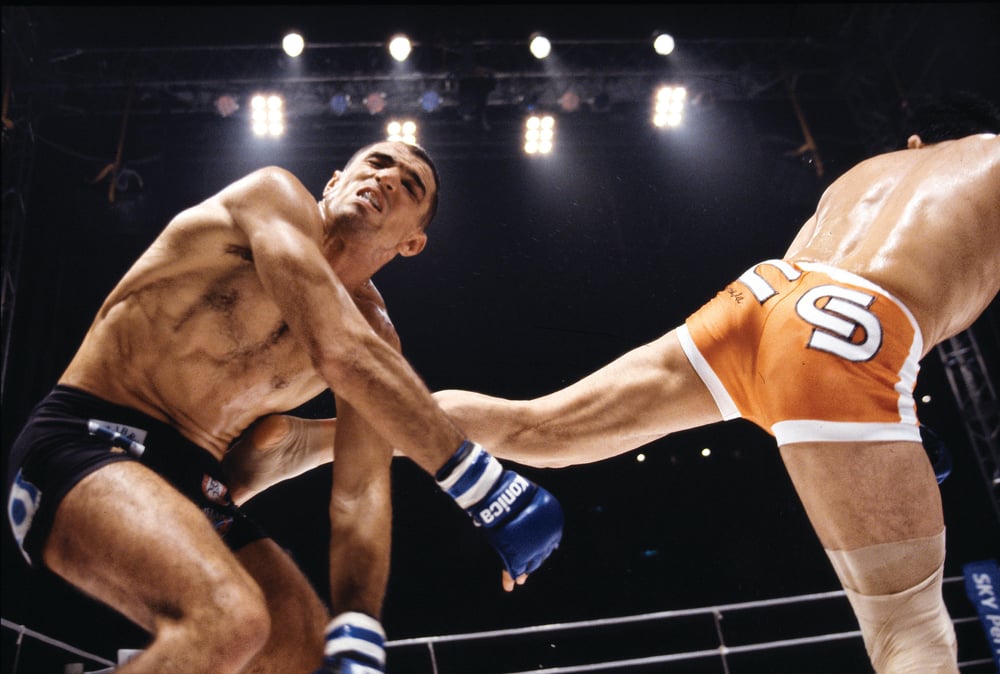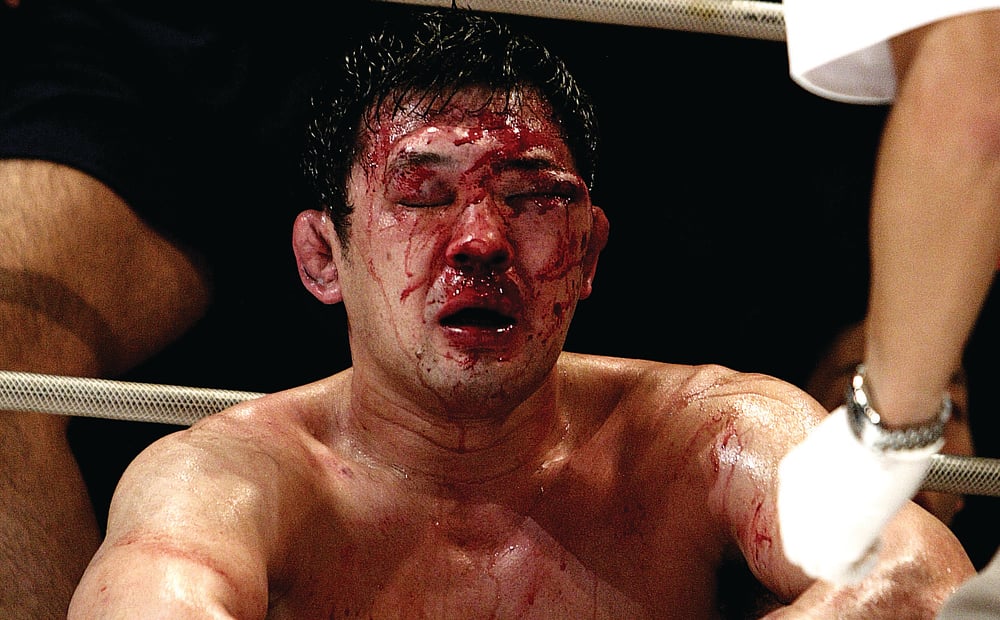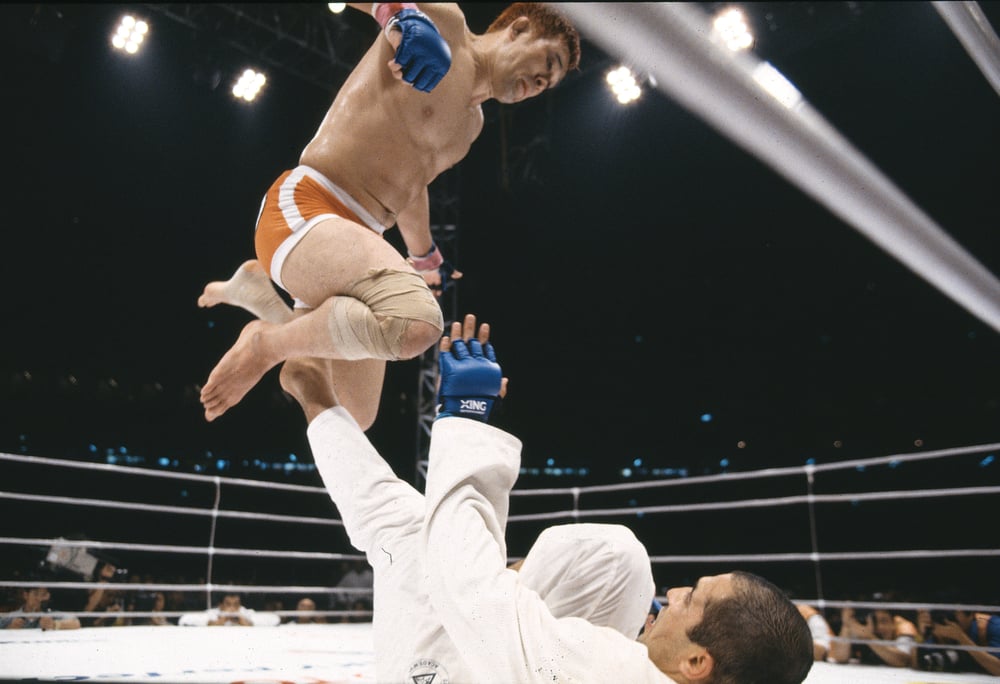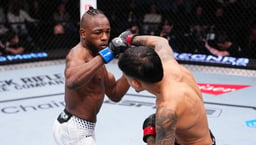
Issue 123
December 2014
You’d think being undersized and overmatched would be a disadvantage for a fighter, but Kazushi Sakuraba based his entire illustrious career on it and became an icon to Pride fans at home in Japan and around the world.
When Kazushi Sakuraba first stepped inside the Pride ring on March 15th, 1998, those in attendance at the Yokohama Arena likely thought they were about to witness one of their countrymen get thrown to the wolves.
His opponent that night was Vernon ‘Tiger’ White. The American, who fought out of Ken Shamrock’s notorious Lion’s Den gym, had a significant size and experience advantage over his foe. He outweighed Sakuraba by 20lb of solid muscle and boasted more than 30 bouts on his MMA record, compared to Sakuraba’s three-fight 1-1 (1 NC) résumé. On paper, it should’ve been a one-sided beating.
However, the former pro wrestler had some tricks up his sleeve. White became the first victim of Sakuraba’s incredible 26-fight Pride run when, like many who would follow him, he fell victim to some slick grappling skills. The fight-ending armbar arrived in the third round and the man in the orange shorts had his hand raised. What made his win against White even more impressive is that he barely trained for the contest.
“At that time I didn’t practice at all. I didn’t have a place to practice so I just ran along the Tama River,” Sakuraba laughs, as he explains his MMA beginnings to FO. “Occasionally, I went to Nitadai and practiced wrestling but that was about it.”
The win would prove to be the beginning of his journey to becoming known as ‘Ikiru Densetsu’, or ‘The Living Legend’, among MMA fans around the world due to his ability to defeat the odds, utilizing his showmanship and fearlessness in the midst of sometimes overwhelming adversity.
Despite being known by most for his successes in Pride, Sakuraba’s career began on the popular Japanese professional wrestling circuit where he worked for UWFi and Kingdom Pro Wrestling. It was here where he learned catch-wrestling from famed British instructor Billy Robinson, which he would employ with great success.
However, the spectacle of wrestling began to wane in ‘90s Japan as many people began to question its stars’ fighting ability compared to those in the emerging MMA scene. Fighters like those from the Gracie family, who had cast a spell on the combat sports world with their dominance in challenge matches and one-night MMA tournaments across the globe. Sakuraba would be key in changing that perception.
With new striking skills and an introduction to BJJ, Sakuraba had a few extra weapons in his arsenal and he took out a stream of quality fighters in his next few fights including Carlos Newton and Vitor Belfort.

He became a valuable commodity for Pride bosses and excelled in co-headline slots, but his name was truly launched into the MMA stratosphere when he became the first man to submit and defeat Royler Gracie. That match at Pride 8 would also be the catalyst for a feud that pitted the entire Gracie clan against Sakuraba, earning him his other, most famous, pseudonym – ‘The Gracie Hunter’.
It all reached boiling point at the quarter-finals of the Pride 2000 Grand Prix. Sakuraba would shock the world as he took on Royler’s brother Royce – an MMA deity, having won three of the first four UFC tournaments.
With Royce’s reputation came an unprecedented challenge. If he was to fight, it would be under rules of his choosing. There would be no judges' decisions. The fight would play out through as many 15-minute rounds as it took until there was a stoppage. Although Sakuraba didn’t necessarily agree with these conditions he stepped up to fight anyway.
“I didn’t have a vendetta against the Gracie family, there isn’t really much of that inside of me. I knew that like my other opponents, (Royce) Gracie was only human. I knew he would have a weak point. There wasn’t any sort of special consciousness,” Sakuraba says.
“The excitement levels for our fight compared to Pride 1 were getting better too. There was an advertisement on TV and people weren’t just occasionally going ‘Ahh! That was fun.’ The anticipation grew more each time, gradually trying to create something good and that’s why it was a success. The TV adverts really brought the audiences in. I think the audience members who came to the shows were important.
”I was angry because the rules of our fight changed. When everyone was saying we should do a tournament, I was the only one told to go balls out. I don’t like to call people out when they are being selfish, but I thought if they wanted to use their own rules why didn’t they put on their own event? In the press conference, I went typical professional wrestler, got angry and said ‘Winner takes all!’” he laughs.
“Afterwards on my way home in the lobby I bumped into Gracie. I was like, ‘Oh, hey.’ When I did that everyone who was with him was saying things like, ‘You always talk such big talk’. Gracie, however, half laughed, shook my hand and said, ‘Let’s have a good fight’, and we went our separate ways.”
The fight would take place in the quarter-finals of the 2000 Grand Prix and end up as the defining moment of Sakuraba’s career. Using a mixture of unorthodox wrestling, devastating leg kicks and superb conditioning, he forced the Gracie corner to throw in the towel when their fighter couldn’t continue after an incredible 90-minute war.
The fight took its toll as Sakuraba withdrew after one round of his tournament semi-final against Igor Vovchanchyn later that night due to exhaustion. However, his previous performance defined his legendary status.
Despite the magnitude of that occasion, it’s his fight against Royce’s nephew Renzo, and its aftermath, that rank among his favorite memories of all.
“The Renzo Gracie fight (at Pride 10) was good. I thought it was a good match, our strikes looked sloppy but our timing mixed well,” he says. “When he put his weight on me I would get him with a low kick. The kimura I used to win the fight was good technique. When I used it on Renzo it wasn’t something normal, the wrist was being cut off so I twisted with all my might. I think that’s when the joint came off.
“When Pride was in Fukuoka (at Pride 18) we bumped in to each other in the lobby. I told him I was going drinking and he said he wanted to come. Antonio Rodrigo Nogueira was with us that time too. I was very drunk so I was trying to make the atmosphere merry so I grabbed Wada Satoshi and Shimo Yanagi and started hugging them tightly. It was fun!”

A rivalry with another Brazilian fighter would begin soon after. Wanderlei Silva even managed to draw anger out of the ordinarily calm Japanese icon.
“There were all sorts of emotions coming out during that fight,” Sakuraba recalls. “He kept on shouting my name. It felt like he wanted to use another fighter’s popularity to get famous.
“That ‘he makes me so angry’ feeling came back when I saw the VTR before our entrances. They create hate, don’t they? Then when the fight happened, he got a good one in and I thought, ‘How strong is this guy?’”
“I gradually got angrier about everything before the fight and from then I was done. I had tunnel vision. I remember the fight getting exciting and then taking a negative turn.”
‘The Axe Murderer’ scored a TKO via knees and soccer kicks within two minutes. The two would fight again for the inaugural Pride middleweight championship at Pride 17, but this time Sakuraba wanted Silva to drop down in weight so the fight would be fairer.
“I begged him to drop his weight to 90kg,” Sakuraba states. “If you’re 93kg it’s easy to hurt someone who isn’t the same size as you isn’t it? If you were 90kg and you wanted to hurt someone who is 95kg you could do that too.
“I was around 85kg before that fight and I told him it was difficult to stay at that weight many times and he still wouldn’t cut the weight. If there’s a rule against big fighters fighting smaller ones and no one does it then the rule is pointless.”
Silva wasn’t interested and he won via TKO again. He completed a hat-trick with a stunning KO two years later. This almost sacrificial treatment at the hands of the Pride matchmakers was lamented by UFC president Dana White recently: “Sakuraba should’ve fought at 170lb instead of doing all these Japanese freak show fights. They got him destroyed by guys who were two weight classes heavier than him.”
It’s a sentiment that the man himself shares to an extent as he takes a bittersweet look back at those days. However, he still has plenty of fond memories of his time under those brightest of lights.
“Pride was a place that played hardball with my feelings,” admits the now 45-year-old. “In one way, it was quite a selfish place, but it was also somewhere where I met lots and lots of other fighters from around the world who I became friends with.
“I made friends with people from
areas of the world I didn’t even know existed. I don’t speak Portuguese but I got to meet those fighters and shake their hand.”
He adds: “If anything, maybe that’s the best thing pro wrestling and fighting has brought to this world. Everyone is fighting with the force of mortality, crying with all their might, laughing and getting angry. However, when it’s over I know from the bottom of my heart that place gave me some of my best friends.”

Battles against the likes of the Gracies, Silva, Ken Shamrock, Antonio Rogerio Nogueira, Mirko ‘Cro Cop’ – win or lose – made Sakuraba into one of the all-time mixed martial arts fan favorites. Though his 26-16-1 pro record could have been greater if he’d fought fighters his own size, it can’t take away from his status as one of the sport’s true icons.
Renzo Gracie on Sakuraba
“Sakuraba was a stone in our shoes. he was one of the most amazing fighters that came from Japan. You see the people that he beat, it was amazing. he beat people who outweighed him by 50lb”
Why so serious?
It’s not uncommon to find yourself howling with laughter during a Sakuraba fight. His antics incorporated a sense of humor that delighted crowds unlike any other fighter before him.
It takes a special kind of maniac to act like the joker while there’s another man trying to take your head off on the other side of the ring. So why did Sakuraba try to make thousands of people laugh during his biggest fights?
He explains: “I wanted fans to go home happy, but if it’s a clumsy fight from beginning to end people watching will not enjoy it.
“I don’t even want to watch that kind of fight. That’s why I think during a fight if there is one or two parts that the audience can laugh at and find amusing they may feel happy.”
Sakuraba vs. Fedor
Pride was never against pitting two opponents together, regardless of their differences in size, but the real ‘David vs Goliath’ fight fans never got to see was Sakuraba against Pride heavyweight champion Fedor Emelianenko.
According to Sakuraba, although he was usually willing to face bigger competition, he drew the line when it came to ‘The Last Emperor’.
“When two people are the same size, the person who wins is the one of the better technique, the better form. However, when you have to take into consideration the weight of opponents too.,” he tells FO.
“Look, the opponents I was matched up with, in the beginning, the opponents I won against, were pretty much the same weight as myself. I beat Carlos Newton but, of course, Wanderlei beat me. The bigger man will win.
“When I fought Antonio Rogerio Nogueira people were saying, ‘Shouldn’t you fight Fedor?’ I couldn’t do it, I told them, ‘I would get killed.’”
...









